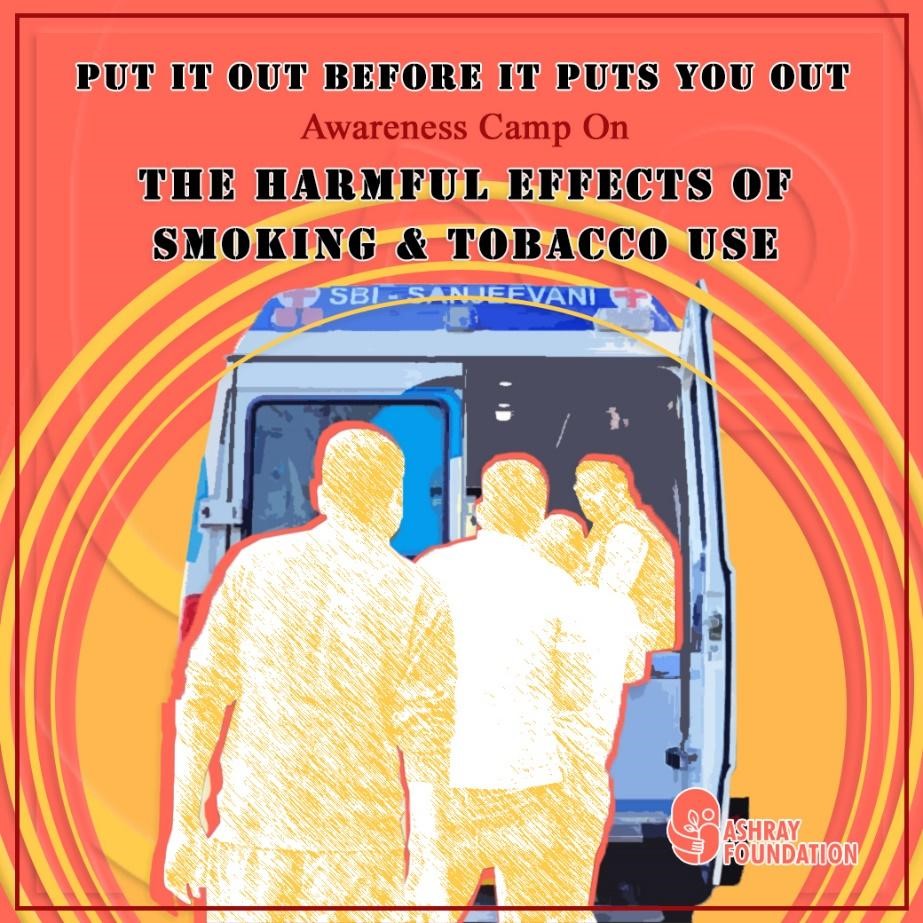PUT IT OUT BEFORE IT PUTS YOU OUT!

A waking call for spreading tobacco awareness in the light of World No Tobacco Day
Author: Srushti Sonawane
“For it so falls out that what we have we prize not to the worth whiles we enjoy it, but being lacked and lost, why, then we rack the value, then we find the virtue that possession would not show us whiles it was ours”
Time and again, we have been warned in and out about the jeopardy of burning the candles on both ends, from choosing the right leaders to simply leading a healthy lifestyle. Shakespeare rightly encapsulates the essence of negligence by taking things for granted and appreciating their worth only after they’re lost, which is applicable to almost every choice made by us. As we recently celebrated World No Tobacco Day 2024 with the theme “Protecting Children from Tobacco Industry Interference,” Ashray Foundation beckons one and all to acutely ponder into the realms of all things harmful through the usage of tobacco products through suggestive remedial measures.
TOBACCO-INDUCED DISEASES:
In an alternate reality, we imagine a disease-free world, healthy ecosystems, and little to no room for the apparition of dreadful encumbrances looming over us. Given our misfortune, it is apparent that today, the use of tobacco has gone way beyond what one could comprehend. Tobacco-related diseases like lung cancer, asthma, and cardiovascular diseases are our frequent visitors, more than we would like them to be. A leading cause of cancer-related deaths, lung cancer, traces its roots back to years of chain smoking, with tobacco’s carcinogens relentlessly attacking lung tissues. Asthma is another discomforting health risk of smoking since the tobacco smoke aggravates its symptoms and increases the frequency of enervating attacks. In cardiovascular diseases, the heart bears a heavy burden from smoking, which accelerates plaque build-up in the arteries, intensifies blood pressure, and restricts oxygen flow, leading to heart attacks and strokes.Calling in for strong tobacco control measures aimed at preventing these preventable yet deadly diseases underscores the critical need to curtail the widespread damages caused by tobacco usage to foster a healthy future for the coming generations.
WAYS TO CURB TOBACCO USAGE:
Amongst many other suggestive methodologies to inhibit the production, usage, and promotion of tobacco-infused products, WHO suggests the following tried and tested methods on how to reduce cigarette smoking and consumption of other tobacco products:
Ban misleading tobacco advertising to lower consumption:
The tobacco industry annually spends tens of billions of dollars marketing its products, using increasingly sophisticated and covert forms of tobacco advertising, promotion, and sponsorship (TAPS). These tactics devastate global health by luring new users into a lifetime of addiction. TAPS especially targets youth, increasing smoking initiation and influencing adolescents even with brief exposure. A comprehensive ban on direct and indirect advertising, as recommended in Article 13 of the WHO Framework Convention on Tobacco Control, can significantly reduce tobacco consumption and protect the public from industry tactics. To make these bans effective, they must be inclusive and cover all forms of marketing.
Reduction of tobacco use by levying effective taxation:
If you imagine the prices of a local store suddenly surging, don’t be too surprised. It’s due to raised taxes on tobacco products. As costs elevate, tobacco becomes less accessible, curbing consumption and deterring youth initiation. Beyond its speculative reach, evidence shows that increasing tobacco excise taxes and prices is the most effective strategy, as outlined in Article 6 of the WHO Framework Convention on Tobacco Control. Some of the advisable practices in the tobacco taxation policy comprise:
- Adoption or transition to a simplified excise tax system.
- Emphasize specific tobacco excise taxes to drive prices effectively.
- Certify that tobacco taxes remain impactful by accounting for inflation and economic growth.
- Utilize straightforward tax structures that discourage consumers from switching to cheaper tobacco brands.
- Incorporate tobacco taxation into a comprehensive strategy to combat tobacco use effectively.
Curb the spread of passive smoking:
The ease of accessibility of these products has made the temptations grow abysmally, creating phony ideals amongst the younger generations. Underage teens are often exposed to the dangers of passive smoking more than one can gauge. Second-hand smoking is a pervasive issue that infiltrates not just homes but also other enclosed spaces where tobacco is being used. Despite its seemingly innocuous presence, second-hand smoke poses serious health risks, contributing to cardiovascular and respiratory diseases. Appallingly, it’s responsible for prematurely ending the lives of approximately 1.3 million people each year. To combat this threat and protect both non-smokers and smokers, the implementation of a complete ban and reducing smoking indoors is crucial to not only shield individuals from the harmful effects of second-hand smoke but also serve as a powerful incentive for smokers to quit smoking. To assist countries in adopting and enforcing tobacco cessation programs, Article 8 of the WHO Framework Convention on Tobacco Control provides essential guidelines for effective action.
Stoppage of the illicit trade of tobacco products:
The illicit trade in tobacco products is a global concern, with approximately 1 in 10 cigarettes being illicitly traded worldwide. Experience shows that addressing this issue can be effective, even with higher tobacco taxes and prices, leading to increased tax revenues and reduced tobacco use. The WHO FCTC Protocol to eliminate the Illicit Trade of Tobacco Products (ITP) is a key tobacco control policy to combat this problem and its health and economic consequences.
Discontinuing the production of newer nicotine products:
Newer tobacco products may present themselves with modern twists, creating varied smoking alternatives, carrying the same old dangers, and luring consumers with innovative tactics while perpetuating addiction and health risks. Their deceptive allure underscores the urgent need for stringent regulations to curb their proliferation and protect public health from evolving threats posed by the tobacco industry, stressing the health benefits of quitting smoking altogether. Heated tobacco products (HTPs) are tobacco products that contain nicotine and toxic chemicals upon heating or activation of a device containing the tobacco. Electronic cigarettes (or e-cigarettes) are the most common form of electronic nicotine delivery systems (ENDS) containing varying amounts of nicotine and harmful emissions and are colloquially referred to as ‘vaping’. Some recent studies suggest that ENDS use can increase the risk of heart disease and lung disorders. These products are highly variable, and some of the toxicants found in the emissions of these products are carcinogens, making them highly dangerous for consumption.
INITIATIVES TO CURB TOBACCO USAGE:
In the wake of the increasing risk of tobacco usage and production, efforts towards tobacco prevention and production are gaining momentum globally. The WHO Framework Convention on Tobacco Control (WHO FCTC) has been instrumental in guiding these actions. ‘Say no to tobacco farming’ is not a conventional but a highly effective initiative in sync with the motive of discontinuing tobacco production. Keeping up with trending topics involving artificial intelligence is indispensable. WHO’s first virtual health worker, Florence, is designed to help 1.3 billion tobacco users to quit by using AI to bust myths around COVID-19 and smoking. Implementing tobacco taxes helps countries avoid the high costs imposed by the tobacco industry, benefiting public health, increasing revenue, and supporting development. India has devised the National Tobacco Control Programme (NTCP), which works for training health and social workers, NGOs, school teachers, and enforcement officers, along with implementing IEC activities, school programs, monitoring tobacco control laws, coordinating with Panchayati Raj Institutions for village-level initiatives, and setting up and strengthening cessation facilities, including the provision of pharmacological treatment facilities at the district level. Amongst many other initiatives implemented by India, a few of them, like the Quit Tobacco Movement (2008), Life se Panga Mat Le Yaar (2011), the Election Campaign (2014), ”Tambakhu Ko Dhishum” (2015), etc., have left a lasting impact on fighting the war against tobacco production and promotion. As we observe these initiatives worldwide, it’s evident that a unified approach is leading us toward a healthier, tobacco-free future, specifically leaning towards the prevention of tobacco use in youth.
In the battle against the tobacco epidemic, the WHO Framework Convention on Tobacco Control (WHO FCTC) was adopted by WHO Member States in 2003, with 182 countries currently signed up. WHO MPOWER measures align perfectly with the FCTC, proving their mettle in saving lives and cutting healthcare costs. MPOWER, being a tobacco control law, has adopted the following measures under their banner to implement their practical approach: Monitoring and reporting tobacco use and prevention policies, protecting folks from tobacco’s grip, lending a hand to kick the habit, sounding the alarm on tobacco’s dangers, stamping out tobacco ads, and giving taxes on tobacco a hefty hike. In all fairness, the exposure of tobacco consumption has risen to a level of comeuppance, leaving the most vulnerable demographic, children and teenagers, in a state of #tobaccoexposed. Embracing a ‘forewarned is forearmed’ approach is a crucial requisite to the battle against tobacco and the grave uncertainties that it holds, protecting children from the tobacco industry interference. Keeping the principle of “Don’t spoil the ship for a ha’p’orth of tar” in mind, in the spirit of World No Tobacco Day, Ashray Foundation alarms everyone to reduce the tar in their lungs before their ship sinks to the bottom.
